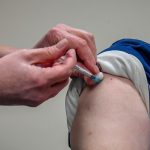Football clubs could have packed grounds from next month as all social restrictions at venues in England are expected to be scrapped on 19 July – so-called “Freedom Day”.
Up to 10,000 supporters were permitted at outdoor sports events from 17 May, including for the final two rounds of matches in the previous Premier League campaign.
But from August, crowd numbers may be back to pre-pandemic levels for the new season.
A final decision on the current restrictions will be made by the government on 12 July, following a review of the latest data.
Live COVID updates from the UK and around the world
Please use Chrome browser for a more accessible video player
The anticipated ending of the remaining COVID-19 rules at places like stadiums and festivals comes under step four of the government’s roadmap out of lockdown.
This includes limits which had previously been imposed over the number of people that can attend an event, along with the one-metre plus rule.
As well as capacity caps being lifted, all remaining businesses will be able to reopen including nightclubs.
Also, the legal requirement to wear face coverings will be removed, although guidance will suggest people might choose to do so in “enclosed and crowded spaces”.
And there will be no compulsory use of COVID status certification – so-called domestic vaccine passports.
Under step three of the roadmap, at indoor events up to 1,000 people or 50% of a venue’s capacity, whichever was lower, had been permitted.
And at outdoor events, up to 4,000 people had been allowed or 50% of a site or venue’s capacity, whichever was lower.
But the government also made a special provision for large, outdoor seated venues where crowds could be safely distributed around the venue, allowing up to 10,000 people or 25% of total seated capacity, whichever was lower.
This provision could be used by venues with a seated capacity of 16,000 or above.
By lifting restrictions, officials have acknowledged COVID-19 cases and deaths would continue to increase – albeit at a much lower level than before the successful vaccination programme – but it was now necessary to find a new way to live with the virus.
At a Downing Street press conference, Boris Johnson admitted the pandemic was “far from over” with cases rising “fairly rapidly”.
“There could be 50,000 cases detected per day by the 19th,” the prime minister said.
“We are seeing rising hospital admissions and we must reconcile ourselves, sadly, to more deaths from COVID.”
It means the stadium will be at 75% capacity for the games.
And from Tuesday, Wimbledon’s two biggest courts will host maximum capacity crowds for the quarter-finals, semi-finals and finals.
It will be the first major sporting event in the UK to host full capacity crowds in nearly 18 months, after pandemic-enforced limits on social gatherings.
The southwest London tennis tournament is part of the government’s Events Research Programme (ERP), with stands in the first week of the event allowed to operate at 50% capacity and fans able to remove their masks in the stadiums.
From Tuesday, Centre Court will hold just shy of 15,000 spectators and Court One will host 12,345 fans, as Wimbledon reaches its climax.
Capacity across the rest of the All England Club will be reduced as less courts are used as the tournament progresses.
Reacting to Monday’s news, the Premier League said in a statement: “Fans have been hugely missed so we welcome today’s announcement by the government, and are looking forward to full stadiums in the 2021/22 season.
“As we move towards a government decision on Step 4 of the roadmap and beyond, we will continue to work with football stakeholders and relevant public authorities to ensure that the return to full capacity is done in a way that keeps everyone safe.”
Mark Davyd, founder and chief executive of the Music Venue Trust, said: “This announcement is hugely important and provides the opportunity to revive live music. It does not, however, change the central mission or the importance of the word ‘safely’.
“We are re-energising our efforts to work with our fantastic network of grassroots music venues to ensure that what each of them delivers to the public from July 19 meets the highest standards of COVID security and safety within the new guidelines.”






















